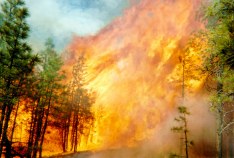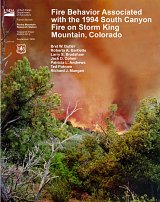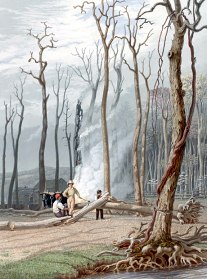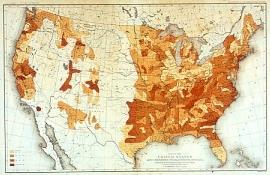History with Fire in Its Eye: An Introduction to Fire in America
Stephen J. Pyne, Arizona State University
©National Humanities Center |
|
(part 1 of 3)
 | slideshow |
 |
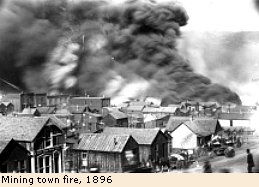
|
photo info
|
"The amount of burning was,
by today's standards, staggering."
|
|
 |
|
For the 1880 census, Charles Sargent mapped forest fires. Fire was nearly everywhere, some places more vigorously than others. The amount of burning was, by today's standards, staggering. A developing nation, still primarily agricultural, the United States had a fire-flushed landscape not unlike those of Brazil and Indonesia in more recent decades. While lightning accounted for some ignition, and steam power (notably locomotives) for a growing fraction, the principal sources of fire were people—people burning for hunting, for traditional foraging, for landclearing, for clearing field fallow, for pasturage, for the ecological equivalent of housecleaning. And of course there was a significant amount of sheer fire littering. Where spark met large caches of combustibles (as around logged sites), horrific fires, implacable as hurricanes, broke out. The idea that one might abolish fire seemed quixotic, in fact, dangerous. Without fire most lands were uninhabitable. Free-burning fires came and went with the seasons, as unstoppable as the movement of the sun across the heavens. Right-thinking conservationists, as good Progressives, argued for government intervention to stop them.
By the end of the 20th century, that scene had changed almost beyond recognition. Everywhere fire's domain was shrinking. Flame had vanished from houses and fields. Its primary habitats were the public lands of the West and those still-rural scenes of the forested South.
The problem with fires became one of maldistribution—too much of the wrong kind of fire, not enough of the right kind. Most fires burned as wildfires, set by lightning, accident, or arson. Many lands suffered from a fire famine, the shock of having a process to which they had long adjusted abruptly removed. On many sites, natural fuels had ratcheted up to levels against which fire suppression stood helpless. Government fire agencies sought to reinstate fire, often at considerable cost and risk, even in the face of public skepticism.
Between 1994 and 2000 the magnitude of the crisis became undeniable. In July 1994 a wildfire, kindled by lightning, overran a fire crew on Storm King Mountain in Colorado and killed fifteen crew members. The fatalities prompted not merely the usual review panels and reports but a profound soul-searching by the federal agencies about what justified putting those lives at risk. A revised federal policy emerged in December 1995. The alternative to fire control, it appeared, was controlled burning. This reflected common wisdom, accrued over the last thirty years.
In April 2000, however, the National Park Service set and lost two burns, the Outlet Fire on the North Rim of the Grand Canyon in Arizona and the Cerro Grande Fire at Bandelier National Monument in New Mexico. The first forced the evacuation of the North Rim and only ceased its run when it breached the canyon's rim. The second scoured the town of Los Alamos like the cutbank of a river. The agencies ordered a standdown from prescribed burning for a month and the Secretary of the Interior placed the Park Service program under a moratorium.
 |
NPS  Outlet Fire, Grand Canyon, 2000
|
"The two options for 'managing' fire—fighting them and lighting them—had both failed, spectacularly."
|
|
|
 |
In truth, the 2000 fire season proved dismal for federal fire agencies, with burned area from wildfires reaching fifty-year highs, prescribed fires escaping, and suppression costs climbing to a stratospheric $1.3 billion. The two options for "managing" fire—fighting them and lighting them—had both failed, spectacularly. Fire suppression alone could not indefinitely contain fire. Yet prescribed fire was not ecological pixie dust that, sprinkled over degraded lands, could render them magically whole. More than starting and stopping ignition and shoving biomass around, the reintroduction of fire was akin to reintroducing a lost species. Fire needed a habitat. A National Fire Plan, authorized in late 2000, sought to begin reforms.
The Humanities of Fire
We hold a species monopoly over fire. With fire we claim a unique ecological niche: this is what we do that no other creature does. Our possession is so fundamental to our understanding of the world that we cannot imagine a world without fire in our hands. Or to restate that point in more evolutionary terms, we cannot imagine another creature possessing it.
Yet while humans come genetically equipped to manipulate fire, we do not come programmed in its use. We apply and withhold it according to social institutions, cultural norms, perceptions of how we see ourselves in nature. Different people have created distinctive fire regimes, as they have distinctive literatures and architectures. In this way fire became both natural and cultural. If fire measures our ecological agency, so how we choose to apply and withhold it testifies to our understanding of that agency and the values, choices, and means by which we act. Fire enters humanity's moral universe, and thus into the scholarly realm of the humanities.
Consider, for example, Sargent's map, a complicated cartography. It records geographic conditions that make fire more plausible in some places than in others (the Northeast, for example, lacks a distinctive fire season; the Southwest experiences one annually). The map includes fires kindled from many sources. Lightning ignited some of them. But mostly people did, not simply out of perversity or recklessness but because fire is a profoundly interactive technology, and very few land-use practices happen without its catalytic presence somewhere in the web of causation.
It remains a map, not an image. Interpretation demands some understanding of fire behavior and fire ecology, and some understanding of how people use fire, because we compete with nature for fire control over the landscape and we compete with one another. Often rival fires clash. People rarely burn exactly as nature does, and what one group considers a controlled burn another might condemn as a wildfire. Interpreting the map thus requires some understanding of human history and how people have expressed their relationship to the natural world.
TeacherServe Home Page
National Humanities Center
7 Alexander Drive, P.O. Box 12256
Research Triangle Park, North Carolina 27709
Phone: (919) 549-0661 Fax: (919) 990-8535
Revised: October 2002
nationalhumanitiescenter.org |


